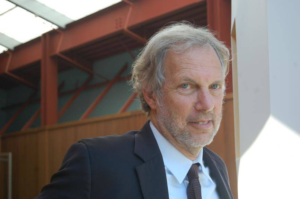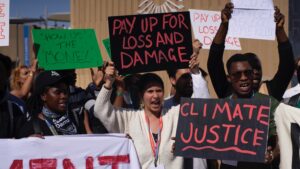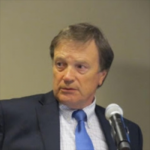
Robert Pollin – Co-Director of the Political Economy Research Institute (PERI) at the University of Massachusetts, Amherst
The specter of inflation is haunting the world’s economies. Surging prices since 2020, especially in food and energy, have eroded global living standards, though inflation varies considerably across countries. However, inflation is hitting the working class and lower-income people harder than wealthier households, triggering protests around the world, especially in countries with strong trade unions and left-wing political parties. In Europe, governments fearful of social unrest have spent hundreds of billions of euros in an attempt to cushion the impact of inflation. The conservative government in Greece has even sought to restrain the increase in prices in more than 50 basic goods with a “household basket” plan. Meanwhile, in the United States — the richest country in the world — government policies to assist those suffering disproportionately from the surge in prices do not even exist.
Why are prices rising, and why do experts think that high inflation isn’t going away anytime soon? Moreover, what type of policies would we expect from a truly progressive government in an effort to curb inflation and bring wages in line with inflation?
Two leading leftist economists from the University of Massachusetts at Amherst, Gerald Epstein and Robert Pollin, shed light on these questions in this exclusive interview for Truthout. Epstein and Pollin are also co-directors of the Political Economy Research Institute (PERI) at UMass-Amherst, which on December 2-3 will host an international conference to explore the causes of inflation and what can be done about it.
C.J. Polychroniou: Bob, the war on Ukraine has not only set back global recovery from the COVID-19 pandemic but also seems to have caused inflationary expectations to soar. Indeed, inflation is haunting most economies around the world, and there seems to be no end in sight for high prices. Why is inflation rising, and what are the main forces behind the creation of large price increases in food, the energy sector and even in housing?
Robert Pollin: Sharply rising inflation rates emerged throughout the world coming out of the 2020-2021 COVID lockdown. According to the International Monetary Fund, the average inflation rate for the overall global economy rose from 3.8 percent in 2019, the year prior to the COVID pandemic onset, to 6.4 percent in 2021, as lockdown conditions from COVID started loosening, and 9.1 percent as of October 2022. For the large high-income economies (G-7 economies), inflation rose from 1.6 percent in 2019 to 5.6 percent in 2021 and to 6.8 percent as of October 2022. The comparable figures for the U.S. economy specifically are 2.1 percent in 2019, 7.4 percent in 2021 and 6.4 percent as of October 2022.
Clearly, the first driver of inflation globally has been the unique economic conditions globally coming out of the COVID lockdown. In particular, the global economy emerged out of the lockdown with supply shortages for a wide range of goods, including oil, food and computer chips, since production of goods had been cut back sharply during the lockdown. On top of that, the shipping industry itself contracted during the lockdown, and has not been able to bounce back quickly. Within the U.S., a major drag has been that there has been, very simply, a shortage of truck drivers to deliver supplies. This has resulted because truck drivers are badly paid. Under COVID conditions, the job also became less safe. One easy solution here would be to raise the pay and improve the safety precautions for the drivers. More people would then want to show up and take these jobs. That still hasn’t happened. Russia’s invasion of Ukraine led to further global supply shortages, in particular for energy and food. This in turn created still more inflationary pressures.
Right-wing commentators like to claim that large government spending levels caused inflation. This position is not entirely wrong, though it is misleading in the way that the right-wing pundits present it. In fact, government spending levels to counteract the COVID lockdown were historically unprecedented throughout the world, amounting to between 15 percent and 30 percent of all economic activity in all major economies. These were government spending levels equal to, if not greater than, World War II. They succeeded in creating a global floor on overall demand — that is, people did still have money in their pockets and bank accounts even while unemployment was spiking with the economic lockdown.
The 2 percent inflation target has primarily been a means of keeping workers’ bargaining power weak and enabling profits and CEO pay to explode.
In other words, overall demand did not fall as much as overall supply. This created a version of the classic mantra on inflation, as resulting from “too much money chasing too few goods.” But consider this problem relative to the alternative that would have resulted under the COVID lockdown in the absence of these government spending injections — i.e., “too little money and too many goods.” That would have produced a major deflation — i.e., falling prices, wages and incomes, along with huge increases in mass unemployment, bankruptcies and a global depression. I have lots of criticisms of the specific ways in which these COVID bailouts were executed. But we are far better off as a result of this government spending, even recognizing how inflation has followed, then to have allowed a global deflation and depression to result.
Under these circumstances of COVID-lockdown and war-related supply shortages, corporations in turn seized the opportunity to mark up their prices and pad their profits margins. Focusing on the U.S. economy, the Financial Times reported on November 28 that, “Margins of retailers and wholesalers have exploded in the past two years. The basic story here is that a combination of broken supply chains, rising input costs, and high demand created pricing power for producers, who raised mark-ups. Those mark-ups … are fueling inflation.” The economist Josh Bivens at the Economic Policy Institute has confirmed this pattern for the U.S., calculating that 54 percent of the price increases for corporations has been due to rising profit margins.
Polychroniou: Can inflation in today’s world be controlled by the actions of national governments? If so, what might a progressive government in the United States be able to do to make prices go down, or otherwise, to increase benefits and wages in line with inflation?
Pollin: The first issue to consider here is how much we should need or want prices to come down. In a paper that I will be presenting at the PERI conference, my coauthor Hanae Bouazza and I show that, considering 130 countries over the 61-year period from 1960-2021, economies have consistently grown at faster rates when inflation ranges between 5 percent and 15 percent as opposed to between 0 percent and 2.5 percent. Generally, this is because when an economy is operating at a high level of activity — with low unemployment rates and strong public sector support — inflation will tend to be somewhat faster. This is not a serious problem as long as workers’ wages and living standards are at least keeping pace with inflation. And as I noted above, this is a far less serious problem than when unemployment is high and wages and living standards are eroding, even while inflation may be at 2 percent or less.
In fact, since the mid-1990s, all high-income countries have been operating under what is termed an “inflation targeting” policy framework. These economies have all set their “inflation targets” at 2 percent inflation. The premise here is that economies perform better when inflation is negligible to nonexistent. But in fact, we have seen in the U.S. that, along with low-to-zero inflation between the early 1990s until the COVID reopening, the buying power of workers’ wages remained stagnant, while the pay for corporate CEOs rose exorbitantly, from being 33 times higher than the average worker in 1978 to 366 times higher in 2019. This is a more than tenfold increase in relative pay for corporate CEOs. So, the 2 percent inflation target has primarily been a means of keeping workers’ bargaining power weak and enabling profits and CEO pay to explode.
Accelerating inflation was harming the real value of wealth held by the top 1 percent and richer strata. The Fed responded by significantly raising interest rates to slow inflation and to try to protect the wealth of the wealthy.
Within this context, it is not surprising that the primary response of policy makers to the global inflationary spike has been to try forcing their economies’ inflation rate down to the 2 percent target rate. Specifically, this has entailed central banks raising the short-term interest rates that they control for the purpose of weakening overall demand in the economy and raising mass unemployment. With mass unemployment rising, worker bargaining power — and along with it, the labor costs faced by businesses — would be expected to decline. Federal Reserve Chair Jerome Powell acknowledged these policy aims clearly, if demurely, in a major speech last August. Powell predicted then that there would “very likely be some softening of labor market conditions” resulting from the Fed raising interest rates.
Despite this singular focus by the Fed and other central banks on raising interest rates and unemployment, this is by no means the only policy tool available that could effectively manage inflation. The Biden administration itself has proposed enacting windfall profit taxes and stricter enforcement of regulations already in place to control corporations monopolistic pricing power. These would counter the excessive mark ups over costs that corporations have been able to impose over the past two years. Additional policy tools could include direct controls in the short term of some key prices, such as oil, along with tighter enforcement of speculation trading on futures markets for oil and food. Still more, increasing infrastructure investments can serve to loosen supply-chain bottlenecks in the short run while raising productivity over the longer term. Advancing a green energy transition — including investments in both energy efficiency and renewable energy — will reduce dependency on volatile fossil fuel markets while also driving down CO2 emissions.
It is possible that these other measures do not operate as forcefully as raising interest rates and unemployment for bringing inflation down to the 2 percent target rate. But the evidence shows that it is not typically necessary to force down inflation to such low levels. Moreover, all of these alternatives offer the critical advantage that they can reduce inflationary pressures without forcing up unemployment rates. It is also critical to note that inflation has been coming down since July. In the U.S., the average rate for the past four months has been 2.7 percent (expressed on an annual basis). At the least, this pattern demonstrates that there is no further need for the Fed to continue trying to force up unemployment in the name of inflation control. Rather, the combination of less stringent inflation-control policies should be more than sufficient now to continue bringing inflation down to an acceptable level.
Polychroniou: Jerry, there are some economists who argue that monetary policy has been the neglected factor behind the recent surge in inflation. Is this a valid argument, especially with regard to inflation in the United States? Moreover, how do central banks control inflation, and how do you assess the role, so far, that central banks and the Fed in particular have played in combatting inflation? It appears that working-class people, globally, are getting the short end of the stick with the policies pursued by central banks in the fight against inflation.

Gerald Epstein is Professor of Economics and a founding Co-Director of the Political Economy Research Institute (PERI) at the University of Massachusetts, Amherst.
Gerald Epstein: The Federal Reserve has two broad areas of responsibility: one is with regard to monetary policy and the second involves financial regulatory policy, which includes both the monitoring and enforcement of financial regulations. When it fails to implement or enforce its regulations sufficiently, then it bails out the financial institutions and markets that have engaged in reckless behavior and are teetering on the edge. Here it is playing its role as “lender of last resort” or more accurately, as the “bailor-in-chief.” To bail out these banks and markets, the Fed tries to keep interest rates very low so they can borrow money cheaply. This also gives banks and wealthy financiers the opportunity to borrow money cheaply and buy and trade financial assets, leading to the massive increases in financial wealth we have observed until recently in the period following the great financial crisis of 2007-2009. Up until the time when Russia invaded Ukraine, the Federal Reserve’s mixture of monetary policy, regulatory (non-) policy and bail-outs led to a gigantic “asset inflation,” but not much of an inflation in the cost of goods and services. The one exception to this may have been in the case of housing and real estate, whose increase in prices were probably partly driven by these low interest rates.
But when supply chain problems from the pandemic hit and Russia’s invasion took hold, then commodity inflation took off. Now the Fed saw that its game of inflating the wealth of the wealthy with low interest rates and bailouts would no longer suffice. The problem: The accelerating inflation was harming the real value of wealth held by the top 1 percent and richer strata. The Fed responded by significantly raising interest rates to slow inflation and to try to protect the wealth of the wealthy. But as Bob Pollin explained, this came at the expense of slower employment growth and even higher unemployment for workers.
As Bob explained, the standard of living of workers and the poor have been significantly hurt by increases in the cost of living associated with the war and supply problems, but higher interest rates, designed to help the wealthy, will only hurt the workers more. Home mortgage costs, interest rates on credit cards and slower wage growth will be the result.
Polychroniou: Assuming you were in a position to affect policymaking in the fight against inflation, what measures would you recommend as an economist of the left?
Epstein: Since Bob discussed this in general, I will focus here on what the Federal Reserve could do. It is often said that the Fed has only one tool — interest rates — and so that is what it is using to fight this inflation. But this is not correct. As the Fed amply showed during the great financial crisis and the onslaught of the COVID pandemic — as well as in previous periods such as during World War II — the Fed has a number of tools in addition to interest rates: these include subsidized lending, asset buying, direct lending for productive purposes, and other more technical tools like asset-based reserve requirements designed to subsidize some lending and penalize other types. If the Fed had the notion (and the political will to pull it off in the face of a potentially hostile Congress), it could lend subsidized credit or buy assets from specialized nonprofit banks devoted to providing low-cost housing; it could provide working capital or buy longer term assets from organizations in communities providing subsidized solar energy and insulation for residences and community buildings; it could provide subsidized credit for farmers and rural communities that are producing healthy food and developing distribution networks that bypass the mega-middle men — buyers, grocery stores etc. that are using their market power to rise food prices. These are just a few examples.
The point is that the Federal Reserve has a huge amount of creative lending and investment strategies during the recent crises mostly to help banks and other financial institutions, but also municipal governments, small businesses and the like, and they could do this again to do two things: Help subsidize key commodities for the working class and poor, and also help increase the supply of key commodities — green energy, healthy food, etc. — that will improve the standard of living of workers in the medium to longer term.
Punishing increases in interest rates are not the only tool the Fed can use, but it is the tool it is choosing.
Source: https://truthout.org/articles/the-feds-response-to-rising-inflation-protects-the-wealthy-at-workers-expense/
C.J. Polychroniou is a political scientist/political economist, author, and journalist who has taught and worked in numerous universities and research centers in Europe and the United States. Currently, his main research interests are in U.S. politics and the political economy of the United States, European economic integration, globalization, climate change and environmental economics, and the deconstruction of neoliberalism’s politico-economic project. He is a regular contributor to Truthout as well as a member of Truthout’s Public Intellectual Project. He has published scores of books and over 1,000 articles which have appeared in a variety of journals, magazines, newspapers and popular news websites. Many of his publications have been translated into a multitude of different languages, including Arabic, Chinese, Croatian, Dutch, French, German, Greek, Italian, Japanese, Portuguese, Russian, Spanish and Turkish. His latest books are Optimism Over Despair: Noam Chomsky On Capitalism, Empire, and Social Change (2017); Climate Crisis and the Global Green New Deal: The Political Economy of Saving the Planet (with Noam Chomsky and Robert Pollin as primary authors, 2020); The Precipice: Neoliberalism, the Pandemic, and the Urgent Need for Radical Change (an anthology of interviews with Noam Chomsky, 2021); and Economics and the Left: Interviews with Progressive Economists (2021).







